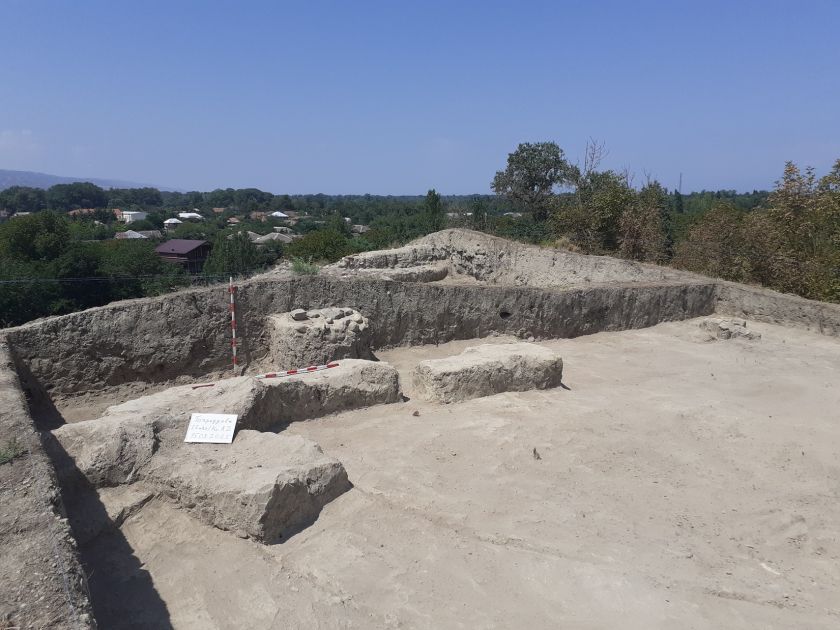Archaeological research that began in 2023 at Torpaqqala, located in Qakh's village of Laleli, remains ongoing, Azernews reports citing the Institute of Archaeology and Anthropology.
During the current season, archaeological excavations at the site were carried out by the expedition of the Institute of Archaeology and Anthropology of the Azerbaijan National Academy of Sciences (ANAS) focused on Alban period archaeological monuments of Northwestern Azerbaijan, led by Doctor of Philosophy in History, Associate Professor Taleh Aliyev.
Torpaqqala is situated on the eastern side of Laleli village, near the confluence where the Qapıçay River flows into the Qanikh (Alazan) River, on the left bank of the latter.
The total area of the site is close to 20 hectares. Torpaqqala mainly consists of three parts: a residential area, a fortress section, and a necropolis. The fortress section covers an area of 0.35 hectares, measuring 50 by 70 meters. According to its general layout, the fortress, located at the southwestern point, served observation and defensive purposes, with ramparts continuing along the entire intact perimeter.
These ramparts are the remains of the fortress’s defensive walls. Archaeological excavations have revealed layers from the Early Iron Age, Antiquity, Early Middle Ages, and Classical Middle Ages at Torpaqqala. Research indicates that dense settlement existed at the site during the late Antique and Early Middle Ages.
The walls uncovered in the fortress section have foundations made of river stones and are built with sun-dried bricks. The inner rooms were constructed from clay molded bricks. Lime mortar was used in plastering the floors.
This year, for the first time, three necropolises were identified on the outskirts of the residential area located in the center of Torpaqqala. The Antique-period necropolis is situated in the southern part, the Early Medieval necropolis in the western part, and the Classical Medieval necropolis in the southeastern part.
Among the ceramic finds uncovered during the excavations are vessels such as jars, pots, cauldrons, vases, glasses, cups, and small bowls in black, red, gray, and yellowish-red colors. Among the clay artifacts are interesting finds like zoomorphic and anthropomorphic children's toys, samples related to weaving crafts, and a clay fox figurine. Pottery pieces bear seals and various markings left by artisans, which are also of interest. Material culture finds also include stone, obsidian, iron arrowheads, as well as bone and charcoal remains.
The discoveries demonstrate that various crafts were practiced among the inhabitants of Torpaqqala during the Antique and Early Middle Ages. The material culture of Torpaqqala shows similarities with artifacts from Mingachevir, Gabala, Almalı Torpaqqala (Qakh), and Qipchaqtapa (Qakh).
Note that the settlement and necropolis of Qipchaqtapa, covering over five hectares, were brought to scholarly attention by the Northwestern Azerbaijan Alban period archaeological monuments expedition under the leadership of Taleh Aliyev in 2017–2018, while in 2021–2022, the Antique-period necropolis was studied, focusing on inhumation graves.
It is also worth mentioning that the ancient author Claudius Ptolemy named 29 settlements of Caucasian Albania in his work "Geography."
Some of these sites are located in the first and second regions shown on Ptolemy’s map. The settlements in the area of the Cambisena province of Albania were mainly situated along riverbanks. Archaeological research suggests that Torpaqqala could be one of these settlements.
Torpaqqala was formed as a settlement at the end of the Early Iron Age and developed into an urban-type site during Antiquity and the Early Middle Ages.
It is tentatively proposed that Torpaqqala corresponds to one of the Albanian settlements "Iobula" or "Adiabla" mentioned by Claudius Ptolemy near the Qanikh (Alazan) River.
The site around Torpaqqala should also be considered a likely location for the Battle of Alazan, fought between the Romans and Albanians in 65 BC.

